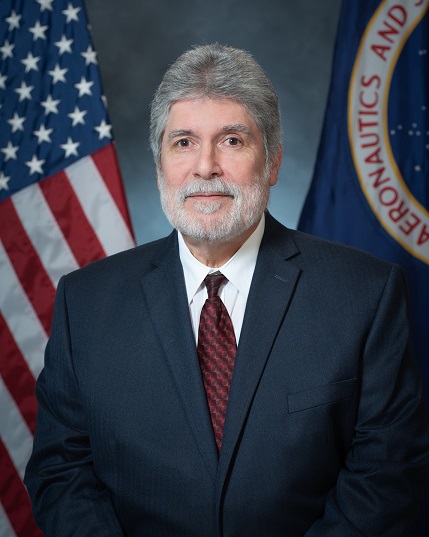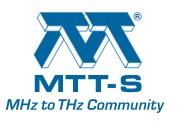
Félix A. Miranda, Ph.D.
Deputy Chief Communications and Intelligent Systems Division
NASA Glenn Research Center
_______
“Aerospace Communications Technology Research and Development at the NASA Glenn Research Center”
_______
Abstract: Aerospace Communications is one of the core competencies of NASA Glenn Research Center (GRC). In this context, GRC over the past few decades has pioneered the advancement of key technologies required for reliable aerospace communications. At present, a significant portion of GRC’s research and development (R&D) efforts in communications is directed towards advancing NASA’s Exploration Systems Development and Aeronautics Mission Directorates program requirements and goals. The Exploration Systems Development Mission Directorate (ESDMD) has a very ambitious vision that is focused primarily on the Artemis Lunar Missions and the Moon-to-Mars (M2M) program, while one of the primary goals of the Aeronautics Mission Directorate is to develop an architecture for Advanced Air Mobility (AAM) systems to enable their reliable operation in the National Air Space (NAS).
Accordingly, in support of the agency M2M Program GRC is partnering with industry to develop advanced Transmit/Receive (Tx/Rx) frontends that depend on vacuum electronics and solid-state devices, such as Traveling Wave Tube Amplifiers (TWTAs) and Gallium Nitrate (GaN) MMIC-based high power amplifiers, respectively. Additionally, MMIC-based phased arrays antennas and reflector antennas are being assessed to enable robust space-to-ground communication links. Furthermore, advanced software defined radios (SDRs) and modems are being investigated to address the data handling requirements. Also, radio wave propagation studies are being conducted to enable communications on the lunar surface.
In the aeronautics realm, GRC is endeavoring in the development of Urban Air Mobility (UAM) communication, navigation, and surveillance (CNS) data service architecture for efficient air traffic management. Additionally, AAM testbeds are being deployed to verify and validate air-to-ground and air-to-air links. GRC is also performing studies in spectrum management, beam-shaping technologies for transmit phased array to be compliant with SATCOM link requirements, and 5G compatible communication systems to enable seamless operation of Unmanned Aerial Vehicles (UAVs) in the NAS. This presentation will discuss the current status and accomplishments of the above R&D efforts at NASA GRC in support of the agency Exploration Systems Development and Aeronautics Mission Directorate programs and goals.
Biography: Dr. Félix A. Miranda is the Deputy Chief, Communications and Intelligent Systems Division, at the NASA Glenn Research Center (GRC) in Cleveland, Ohio. In this capacity, he provides expertise, plans, and directs research and engineering development in the competency fields of advanced communications and intelligent systems technologies for applications in current and future aeronautics and space systems. His areas of expertise are antenna technology and microwave integrated circuits and devices for space and ground-based communications.
Dr. Miranda is a Fellow of the Institute of Electrical and Electronics Engineers (IEEE), a member of the American Institute of Aeronautics and Astronautics (AIAA), a member of the American Physical Society (APS), and a member of the Forum of Industrial and Applied Physicists (FIAP). He serves as Associate Editor for the IEEE Transactions on Antennas and Propagation, and is a reviewer for the IEEE Transactions on Microwave Theory and Techniques, the IEEE Microwave and Wireless Technology Letters, the Journal of Applied Physics, Applied Physics Letters, Thin Solid Films, and ACS’s Applied Materials & Interfaces. He is a member of the Editorial Board of Integrated Ferroelectrics (Taylor & Francis).
Dr. Miranda has authored or co-authored more than 210 journal and conference proceedings publications in his areas of expertise. He has written several book chapters, is the co-editor of several conference proceeding volumes on ferroelectric materials and devices and is the co-editor of the book “Advanced Nanomaterials for Aerospace Applications,” (Pan Stanford Publishing, 2014). He is the co-inventor of fifteen U.S. patents, with one patent pending.
Dr. Miranda is a former NASA Administrator’s Fellow and received the 2001 Outstanding Technical Achievement Award from the Hispanic Engineer National Achievement Awards Conference (HENAAC). He is the recipient of the 2007 NASA Exceptional Service Medal for outstanding technical and managerial leadership in antenna and microwave technologies for space communications. Dr. Miranda received the 2007 R&D100 award from the R&D Magazine for the development of an Antenna Near-Field Probe Station Scanner and is the recipient of the 2009 NASA Equal Employment Opportunity Medal for exceptional contributions to the goals of the Equal Employment Opportunity Program through work with under-represented universities and students.
Dr. Miranda received the 2009 Wall Street Journal’s Technology Innovation Award as a runner-up in the wireless category for the invention, “Miniature Implantable Radio Frequency System for Real Time Telemetry from Microelectromechanical Systems Based Sensors and Actuators.” Dr. Miranda was awarded the 2010 NorTech Innovation Award for “Radio Frequency Telemetry System for Implantable Bio-MEMS Sensors.” He is also the recipient of the 2010 R&D100 award for the development of a “Thin Film Ferroelectric High Resolution Scanning Reflectarray Antenna for Aerospace Communications,” and received the 2010 NASA Glenn Research Center Diversity Leadership Award for his efforts to promote and further diversity in science and technology. Dr. Miranda is the recipient of the 2015 R&D100 award for the development of Polyimide-Aerogel Based Antennas, and received the 2023 NASA Outstanding Leadership Medal for outstanding contributions in advancing the communications competency at NASA GRC.


